May 4th, 2009
| 4 Comments »
I’m the total opposite of this guy.

Instead of warily watching over the masses, determining who best to give a bowl of soup to and weeding out the undeserving, I would be holding the door open, waving folks inside and pushing bowls into their hands; bowls of steaming, hearty and delicious soup with plenty of great bread for dunking.
I am no Soup Nazi. I’m a Soup Queen. We’re in May now, and I still can be swayed by a bowl of soup; I can read a recipe that is more suited to November’s chill, a thick blanket of fleece and a crackling fire and regardless of the fact that Spring is quite literally bursting out of it’s seams outside, I find myself lusting for that soup. It’s really a huge turn from even a few years ago. I used to never make soup. In fact, it intimidated me and I can’t explain why. I think I tried to make it on several occasions and was met with a thin, watery extraction, flavorless and vague that did nothing to satisfy the need inside of me for warmth or comfort. I can’t say; I’ve obviously blanked out the bad experiences of it. Back then, soup was a can for me, sad as it is. I cranked open a tin container to achieve a highly prized level of comfort, and wistfully dreamed of the steaming pot, bobbing with colorful vegetables and thick cuts of meat, or dripping with toothsome noodles and wished for the ability to do it from the ground up.
Obviously, what I didn’t know about soup was that it really needs to be built from the ground up in order to achieve that amazing soup quality that we all crave. Getting this…..
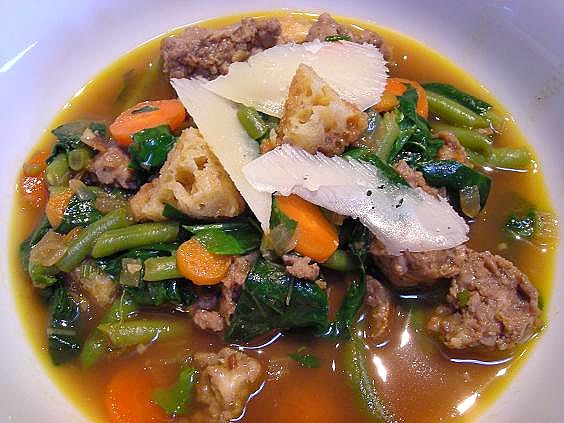
requires little else but a few tidbits of knowledge. Armed with that knowledge, I’ve knocked out soups by the score, at least one pot a week and often more.
Mmmmm, you can almost smell it, can’t you?
The origin of soup can be traced back nearly 6000 years. The word ‘soup’ is believed to have evolved from the term ‘sop’, when long before eating utensils were created and everything was consumed with your fingers, getting those precious drops of juices in the bottom of your bowl was necessary. A thick hunk of bread accomplished this task nicely.

Surprisingly, the word ‘restaurant‘ comes from a term first associated with soup, when in the 16th century in France, a highly concentrated and nutritious food known as a ‘restaurer‘ was sold by street vendors, advertised as an antidote to physical exhaustion. A Parisian entrepreneur opened a shop in 1765 specializing in servings ‘restaurers’, and the term ‘restaurant’ was coined to describe it. The ‘restaurer’ being served was but a humble bowl of soup used as a means to rejuvenate from the trappings of modern life. It’s no wonder that now, many hundreds of years later, when we crave comfort and seek solace from our own modern world, that a bowl of soup feels like a restorative shot in the arm.

Soup grew in popularity with the onset of canning in the 19th century, and today there are hundreds of options available in the supermarket; dried, canned and all designed to be quick and easy. There is soup for all weather too, and a soup found in all cultures, all cuisines and in every form from around the world. We have classic soups, cold soups, fruit soups and herb soups. It can be called bisque, chowder, stew and consomme. The Chinese have Egg Drop and Birds Nest soup; the Greek have their Avgolemono, Scots their Cock-a-Leekie, the French serve Bouillabaise, Hungarians love their Goulash, Russians their Borscht, the Spanish and Portugese revere their Gazpacho. Heated arguments ensue over which clam chowder is better- New England cream based, or Manhattan tomato based- and Gumbo pots simmer throughout the Southern United States. Ever heard of Canh Chua? Revithia? Caldo Verde? Lan Sikik? Callaloo? Fasolada? Bourou-Bourou? Kharcho? Snert? They’re all traditional, cultural representations of soup. Anthony Bourdain claimed that he fell in love with food after eating a bowl of Vichyssoise when he was a boy. And in the 80’s, a flash in the pan boy band went by the name Menudo. Soup is everywhere.
There tends to be a mindset about making soup that it has to take a long time in order for it to be good. While there is something to be said about creating a deep and flavorful pot, simmered for hours at a time, with the ingredients on hand and a quick turn with your knife, soup can be on the table in less than an hour. My Recipe Index has lots of good options for both an easy spin on the stove and a good pot to create over a lazy afternoon.
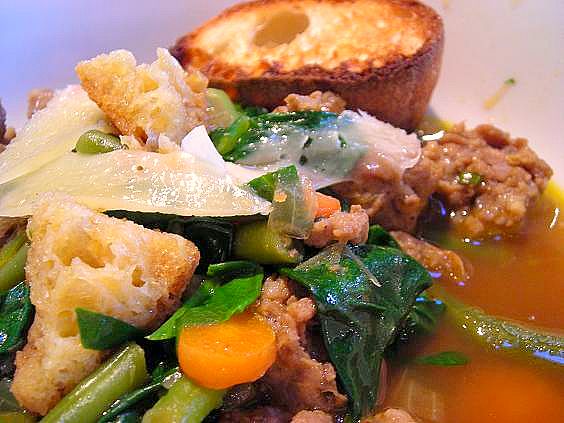 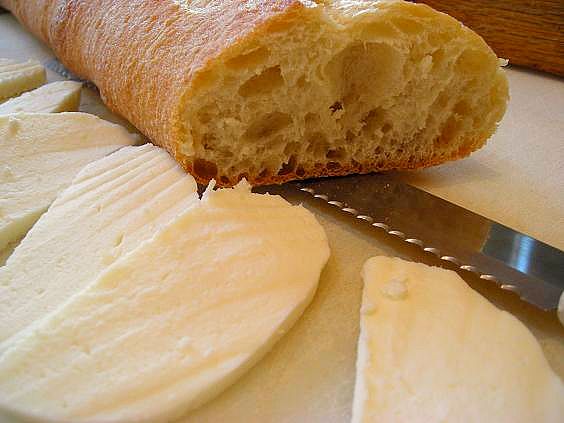
This soup- Zuppa Arcidossana or Rustic Italian Bread Soup- the recipe that prompted me to make a hearty rich Fall-like pot on a beautiful- but cool- Spring afternoon, was one of the simple means to that steaming goodness. Browsing through the New York Times Dining section each Wednesday often gets me in a state like this; I spot a recipe I know I would love and my mad culinary brain must have it. Now. It’s all Bittman’s fault. The soup was simple, hearty and really flavorful, not to mention very quick.
Zuppa Arcidossana
2 tablespoons olive oil
1/4 pound sweet Italian sausage, removed from casings
1 cup 1/2-inch-diced carrots
1 large onion, chopped
3 or 4 cloves garlic, chopped
Salt and black pepper
1 cup stale bread (use coarse, country-style bread), cut in 1/2-inch cubes
1/2 pound spinach, trimmed, washed and roughly chopped
1/4 to 1/2 cup ricotta salata, cut in 1/2-inch cubes (feta may be substituted)
1/4 cup freshly chopped parsley, optional.
Put oil in a large pot or deep skillet and brown sausage over medium-low heat, stirring occasionally. When sausage is cooked through and leaving brown bits in pan, add carrots, onion and garlic, and continue to cook until vegetables begin to soften and brown, about 10 minutes. Sprinkle with salt and pepper.
Add bread to pan and stir for a minute or 2; add spinach and continue cooking just until it wilts, a couple of minutes.
Add about 2 cups water and stir to loosen any remaining brown bits from pan. This is more of a stew than a soup, but there should be some broth, so add another cup of water if necessary. When broth is consistency of thin gravy, ladle stew into serving bowls and top with cheese and some freshly chopped parsley if you have it. Serve immediately.
Mark Bittman, NY Times, 4/29/09
KATE’S NOTES:
Browning the vegetables adds a lot of flavor. I browned the carrot, garlic and onion for quite some time before adding in the sausage and giving it a good searing as well. Since you are only adding water, the fond on the pan will add an immense depth to the pot.
I had some leftover green beans from a previous dinner that ended up in the soup as well. The bread I used was a baguette, and it wasn’t stale; I just cut off the super crusty ends and added them into the soup pot. The slices were toasted to make them nice and crunchy, then set in the broth to soften slightly. I added about a teaspoon of fresh rosemary for extra flavor.
Instead of ricotta, I used fresh mozzarella and of course, shaved parmesan which this soup absolutely cries out for in droves. Basil would also make a good garnish on the top.
April 22nd, 2009
| 2 Comments »
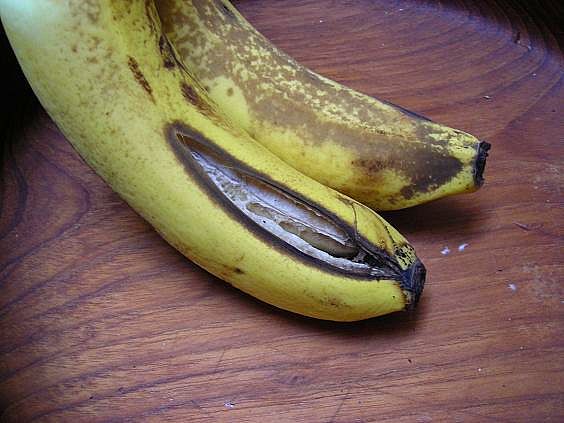 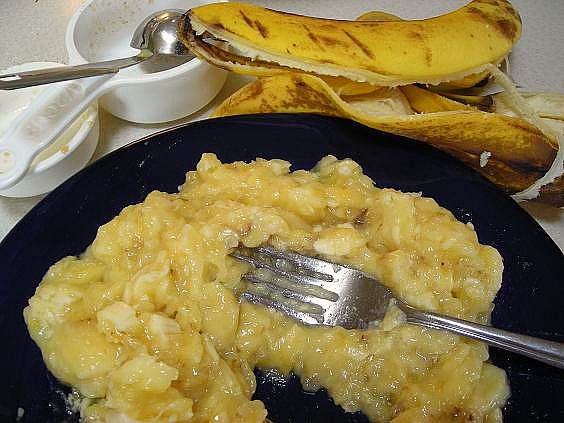 
Banana Bran Muffins
Mix in bowl until blended:
1 1/2 c. buttermilk
2 large eggs
2 T. butter, melted
1/3 c. unsweetened applesauce
Add in 1 1/2 c. All Bran cereal and 1/2 c. whole oats; stir to combine. Allow to sit for 15 minutes, stirring occasionally.
Mash two ripe bananas on a plate and set aside.
In separate bowl, sift together:
3/4 c. AP flour
3/4 c. whole wheat flour
1/4 c. brown sugar
1 t. EACH baking powder and baking soda
1/4 t. salt
2 T. ground flax seed
Gently stir the bananas into the milk/bran mixture. Combine the wet ingredients with the dry and fold gently to incorporate. Do not overmix. Scoop into muffin tins lined with paper cups (or sprayed) and bake at 375° for 20-25 minutes, or until tops are springy. Cool on wire rack.
KATE’S NOTES:
Regular milk, or soy milk can be subbed for buttermilk. To make buttermilk (or sour milk) mix one teaspoon vinegar or lemon juice per cup of regular milk. Stir to combine and allow to sit until curdled. Plain or vanilla yogurt can also be used- stir about 1 cup of yogurt with half a cup of water.
This recipe is wonderful with frozen or fresh blueberries. Toss one cup of fresh washed berries with a tablespoon of flour to keep them from sinking. For using frozen blueberries, gently fold them in, undrained and unrinsed, after you incorporate the wet and dry ingredients. Lemon zest is particularly nice with a blueberry addition; use about a teaspoon or two, with an additional 2 tablespoons of juice as well. Shredded apples also make a nice fruit substitution. Core and shred about two small tart apples and add to wet ingredients. You can stir in a half cup of extra applesauce with the wet ingredients, or even use apple butter (same proportion) for more flavor.
April 20th, 2009
| 9 Comments »
There’s a glut of food blogs on the ‘net, have you noticed? I’ve been trolling for some new inspiration, awesome lurk-worthy sites that are an instant source of excitement, chock full of recipes that I can’t wait to make.
I found myself gasping at what was in front of me; I was a bit taken aback, like thinking I fell into another era. The posts talked about mac and cheese, baked potatoes covered with canned soup, casseroles with frozen vegetables and potatoes, grilled cheese sandwiches with perfect squares of fake cheese…..and please excuse me for sounding snobbish as I certainly know I do right about now…. but this is the food that Jamie and I joke and laugh about, the stuff we were forced to eat coming of age in the 1970’s from mothers who only knew about Betty Crocker and The Joy of Cooking. This is not, in all our 2009 understanding about our food, our health, the way we can nurture and protect ourselves from the plate up; this is not food. I’m sorry. Forgive the mini-rant, it’s done now.
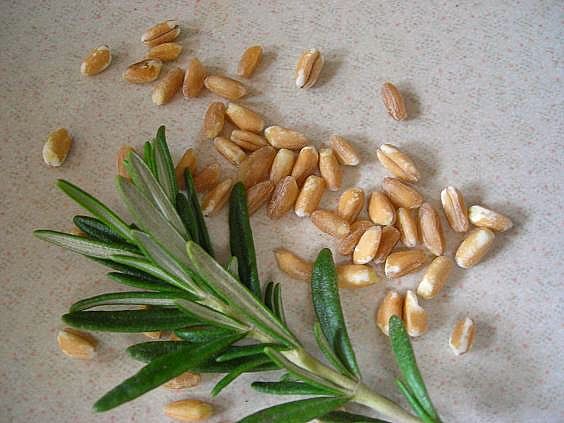
It gets better….I promise- read on…….
Come in to my kitchen…
March 30th, 2009
| 7 Comments »
Sometimes, when I frantically yank on my ‘Iron Chef’ hat with dinner staring me in the face, what I pull from my pantry and fridge to make a meal is memorable, but never something I would do again; it worked for the moment but that’s about it.
Not this focaccia. This one will be here to stay.
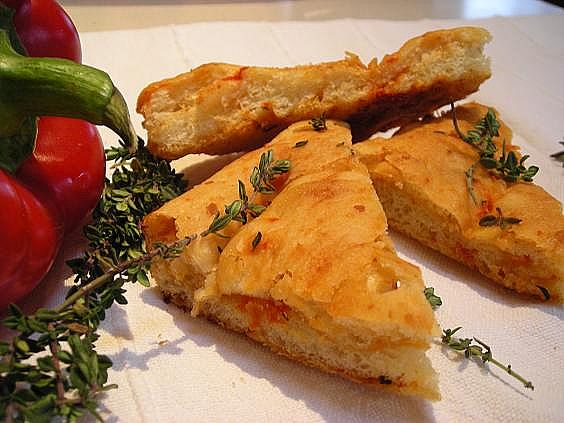
I’m still loving this book, and legally can possess it without monetary fine for another few weeks before the library politely expects its return so I’m trying to dig in deep and fill more pages with flour and watermarks, but so far I’ve managed to use this focaccia recipe enough that the book falls open to the page with little effort.
I love me a good focaccia.
This particular bread is a wonderful canvas for a wide array of toppings- everyone loves a good sea-salt sprinkled chunk, dipped in a little olive oil touched with fresh ground pepper; you can top a foccacia with grated parmesan cheese and herbs, tomato slices and asiago, red wine soaked mushrooms and rosemary……the list is endless. And unlike some bread recipes, this focaccia has one rise, then you form it in your baking pan, leave it for maybe a half hour to puff up a bit, then bake it. The hardest part, really, is waiting for it to cool enough to slice.
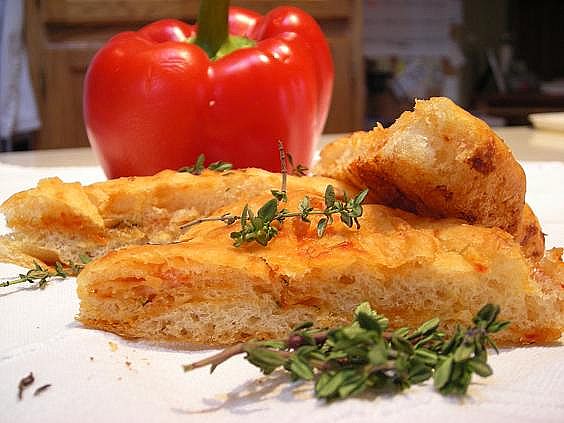

Read on…….
Come in to my kitchen…
March 25th, 2009
| 5 Comments »
I am one of those cooks who use recipes only as a fundamental guideline to a finished product. I can trust my own cooking skills enough, and what I know about how my family eats, to be confident when I look at a recipe in determining what ingredients in it won’t work, or what needs to be enhanced. Even simple basic products can be made better with a little creativity and an eye towards a higher nutritional value.
Take a jar of spaghetti sauce. It’s high on the convenience scale, and has a reasonable amount of nutritional value, provided you avoid the sugar-laden brands and stick with a purer variety. With the addition of sauteed onion and garlic, along with shredded zucchini, carrot and spinach, a few chopped fresh roma tomatoes, some fresh basil or rosemary and a little tomato paste to bring it all together, you get a pasta sauce brimming with vegeteble content, better flavor and more nutrition.
I often come across recipes too, that when I do follow them to the letter and get that anticipatory excitement of what the finished product will be, I often end up sorely disappointed, especially if I ignore my inner urgings to add something of my own liking. It is a rare occurence indeed when I work through a recipe and come to a conclusion, after following the prescribed steps, that what I see in front of me might be way better than what the original end result offered. That was the case with this Savory Millet Risotto.
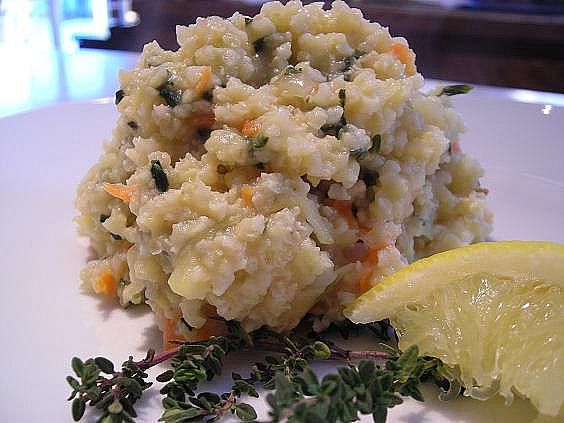
The recipe, from the current issue of Eating Well magazine, was supposed to be for a Millet Cake, similar in structure and use to Polenta. Even though I have given up on using Polenta in any of my meals after repeated attempts to enjoy it always fell flat, I earmarked this recipe as an option. The millet cooks with shredded vegetables, parmesan cheese, fresh thyme and lemon zest to a creamy consistency, at which point it would be cooled, then shaped into patties to sear in a pan. It never made it that far.
Come in to my kitchen…
March 21st, 2009
| 10 Comments »
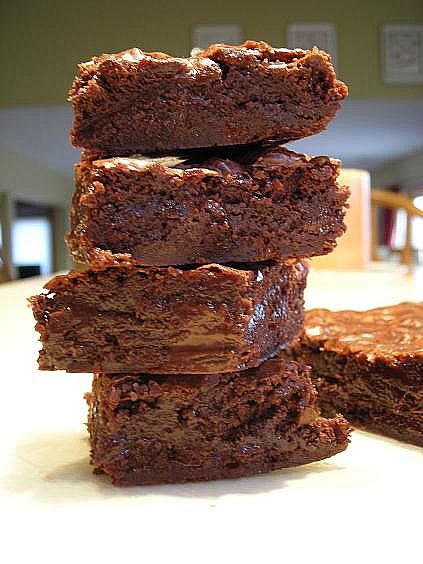 Tell me if you think those look like they are low in fat. Tell me if you think those look like they are low in fat.
Uh huh, yeah…… a low fat brownie. Oh, and do they look like they might taste pretty good? Rich and fudgey like a true brownie should? Gooey in the center with a nice firm edge that’s chewy, but soft too?? A low-fat brownie that may never pass as one if you didn’t give it away?
Well that was the goal, for certain; I was just convinced -utterly convinced -that it would never happen. I mean- a Brownie! Low fat?!- doesn’t seem possible, especially one that tastes like a fudge filled chunk of chocolate dynamite in your mouth, a small chunk so totally satisfying, but surprisingly light and full of all that good earthy brownie flavor that you crave, that sends you into chocolate nirvana. Can it be achieved without 2 sticks of butter, 2 cups of sugar and 4 eggs?
Apparently, it can. But I was mighty skeptical.
There are few baked goods that scream pure decadence like a really good chocolate brownie, yet all that richness comes at a pretty high cost calorie wise, and in fat. While they’re nice once in a while, to have them around when you’re trying hard to look good for the very-quickly-approaching time of year when the layers are shed and the body is finally exposed again, they wouldn’t be on the top of the list to indulge in. So what do you do when a Brownie Craving hits you like a freight train? Well….
Come in to my kitchen…
March 15th, 2009
| 3 Comments »
Seemingly a whole lifetime ago, I worked for five years in the office of a wholesale bakery and I have to say, the smell of yeast has been and still is one of my most favorite smells of all. I loved walking through the production area in the early afternoons as the baking staff began their daily preparations; I loved standing by the enormous mixing bowls as hundreds of pounds of bread dough, pungent with the scent of yeast and flour, spun and smacked around inside. It was a happy day indeed when my boss would inform me that they would be making test batches that day because I knew he would be bringing me endless samples of warm bread to critique. And the best perk was free bread for the taking- crispy baguettes that snapped when you broke them, showering golden shards of crust everywhere, tangy sourdoughs, pillowy stirato loaves, rustic wheat breads and a mouth-watering marble rye that was my favorite sandwich loaf. The best lunch I could indulge myself in was a sliced baguette spread with a little of their scratch aioli and a few slices of salty ham. I was in carb heaven. I still miss the amazing bread, and it’s been a very long time since I last walked through those doors. I can buy the loaves in the grocers, and the flavor is still good, but I miss the experience of picking up a loaf off the rack that was only hours out of the oven, ethereal in it’s taste.
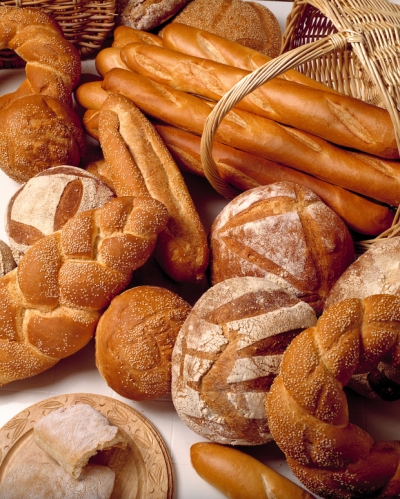 I still love really good bread and for a long time I routinely spun loads of flour, water and yeast in my bread machine, so much so that I managed to effectively kill the thing outright, but I’m happy to have gotten my money’s worth. Since then, which was quite a while ago, I haven’t made a lot of bread from scratch despite having the time and the desire for it. I experimented with this amazing no-knead bread and loved the rich dense crumb and tangy flavor, but I am plagued with a ‘Must Have It Now’ mentality sometimes, and this just doesn’t work well with the patience and time required for a good loaf of scratch bread. There are some high quality artisan bakeries in the Twin Cities, including my old employ, and for a short trip in the car I can pick up a few loaves of bread to indulge myself in, but what I really need to do instead is lose the impatience inside of me and buckle down to make myself a good loaf on a regular basis. I still love really good bread and for a long time I routinely spun loads of flour, water and yeast in my bread machine, so much so that I managed to effectively kill the thing outright, but I’m happy to have gotten my money’s worth. Since then, which was quite a while ago, I haven’t made a lot of bread from scratch despite having the time and the desire for it. I experimented with this amazing no-knead bread and loved the rich dense crumb and tangy flavor, but I am plagued with a ‘Must Have It Now’ mentality sometimes, and this just doesn’t work well with the patience and time required for a good loaf of scratch bread. There are some high quality artisan bakeries in the Twin Cities, including my old employ, and for a short trip in the car I can pick up a few loaves of bread to indulge myself in, but what I really need to do instead is lose the impatience inside of me and buckle down to make myself a good loaf on a regular basis.
On a recent trip through the library, I came across the publication of a local group called The Saint Paul Bread Club. I barely hesitated before slipping the slim book off the shelf. It’s basic and fundamental, nothing glossy or fancy, just page after page of bread recipes from a local group of passionate bread bakers, along with plenty of insider tips and hints to making better breads at home. After a few perusals and some thought to the first loaf to try, I rolled out of bed on a particularly gloomy morning after a simply pathetic night’s sleep and all I could think about was the smell of yeast, a warm glowing oven and the taste of a fresh warm loaf. The weather promised everything from rain to an eventual accumulation of upwards of 6″ of snow. It instilled in me both a bluesy melancholy, and a fierce need for the routine of baking, the rhythmic kneading and the promise of carbohydrates.

This loaf contained bulgur and millet and I had both on hand. Bulgur is cracked and parboiled wheat and really simple to use- it requires little else but a soak in hot water. Millet is a hulled, wheat-free cereal grain- the outer husk is removed leaving tiny yellow balls. Millet requires cooking, but this recipe didn’t make any mention of pre-cooking the grain so I didn’t, and it plagued me on whether or not this would result in a tooth-cracking slice. It didn’t.

This recipe started with a sponge- honey, warm water and yeast were whisked together until foamy, then stirred with whole wheat flour, bulgur, oil and salt and allowed to sit until all puffy and fragrant. I mixed in the bread flour and millet, and pretty soon was faced with a coarse hairy blob of dough, and tiny grains of millet popping all over the kitchen. It seemed like hours before I stopped feeling their little hard knobs under my feet, even with obsessive sweeping. But the magic of kneading kicks in- and magic it is- taking a rough and craggy blob and transforming it into something smooth, elastic and uniform, dotted with the tiny yellow points of millet and smelling alive and warm.
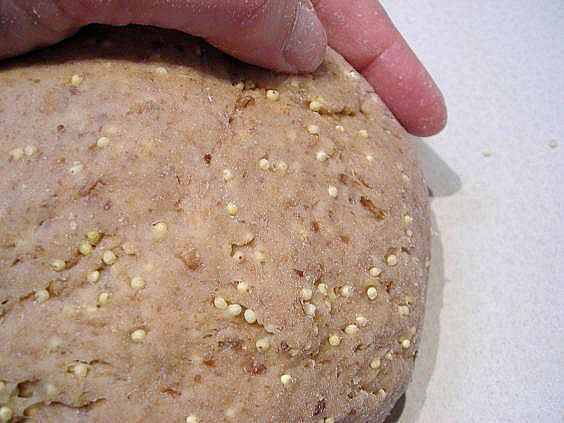 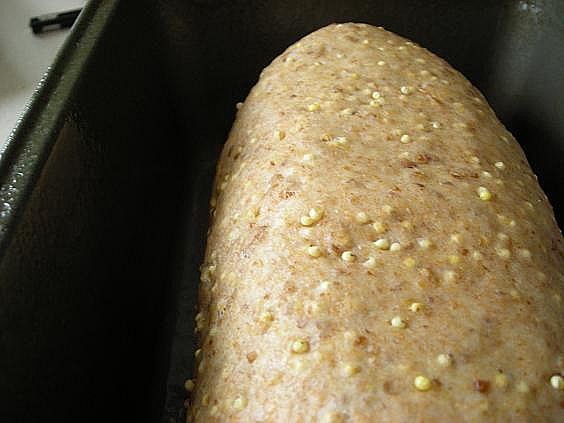 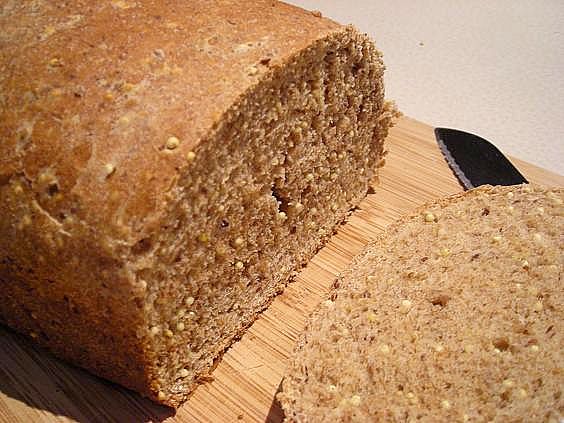
The rest is your basic bread instructions; rise until doubled, punch down and allow another rise (which I skipped for time purposes) shape the loaves and place in a pan, rise to double again and then bake. I won’t bore you with instructions.
And somewhere along the way, amidst all this tactile interaction and flour/yeast transformation, a tiny sliver of light knifed through me, lifting the melancholy, driving it far away. Was it the nap I took during the first rise? Maybe. It likely was something else altogether; the bread making lifted my spirits, even with the late winter storm blowing hard outside and the yeast saturated me with it’s own little charm. It could have been the workout I gave my arms and shoulders as I kneaded, driving a much appreciated blast of endorphins into me, or it could have been the fact that a hands-on loaf of bread is a thing of beauty. It transports you back to a simpler time, before cellophane loaves were the norm, where you watch a few pantry staples work a magic trick right before your very eyes. It’s nearly impossible to bury yourself in the blues with that happening in front of you.
And the taste….well, that’s enough right there to lift your spirits. This loaf was moist, a nice dense crust and crunchy little bites of millet throughout. It made awesome toast too- to me, the best indicator of a good bread. I’m thinking that I need to buy this little bread book.
(recipe after the jump)
Come in to my kitchen…
February 22nd, 2009
| 6 Comments »
We all have events in our lives that aren’t the most pleasant to look back on, but when traced with the correct pencil of perspective we can firmly point out maybe a benefit or two gained from the experience. This Sesame Seared Salmon is one of the good things that came from a not-too-pleasant occasion during my culinary school days.
I was a member of our school’s culinary competition team. The local culinary schools engage in a friendly student competition each year at a big food show that goes on in February. We started our practices in October, meeting once a week to work on knife skills and a four-course menu that needed to be done in a 90 minutes window on the day of the competition. The whole thing was fraught with elements of disaster from the start, mostly due to one team member who was so bloated with self-importance that he refused to allow anyone to tell him what to do or work with anyone else on the team to make it a smooth venture. No amount of nagging or threats could get the team captain to kick him off and replace him with someone easier to work with. We plodded on, although I knew the whole thing was going to be only slightly less catastrophic than a thunderous tsunami.
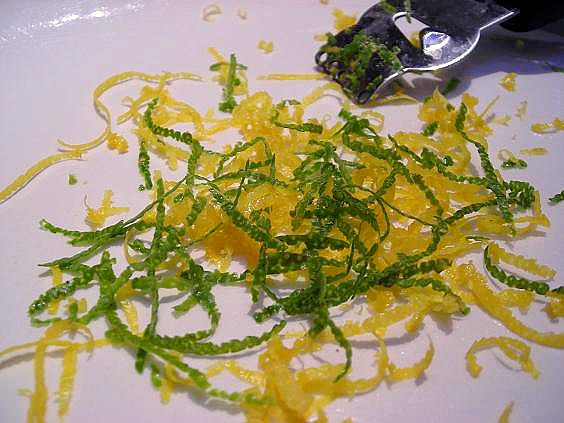
My part of the team was to do the appetizer and I did a three part salmon plate; one was a Salmon Tartare in a Savory Cornet shell, the other was a Vegetable Bisque with Seared Salmon and the third was bite-sized nuggets of this gorgeous Sesame Seared Salmon. Outside of absolutely loving the Sesame salmon, making a friend for life in my teammate Emily and getting to spend a lot of time with some amazing chef mentors who taught me a great deal, the entire incident was one that I often look at with utmost regret. We placed dead last and quite frankly, it was a little embarrassing to go up against schools who spent an entire year prior to the competition in a class that did nothing but mold them for the end result. We looked like a group of rusty, beat up old clunkers at a Porsche convention.
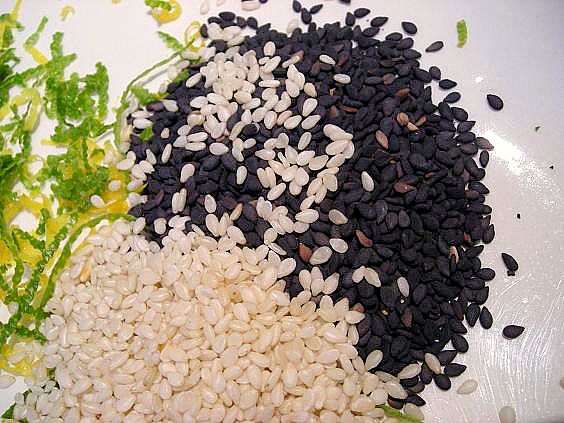
This salmon, however, was all my creation and I couldn’t have been more pleased with it. I really need to make it more often.
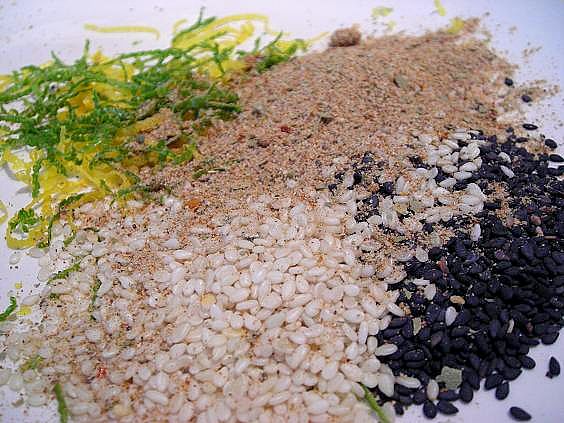
The seasoning is a simple blend of Old Bay, lemon and lime zest, a little squeeze of either juice, salt and pepper and a mix of black and white sesame seeds. Press the fish into the mix, heat a skillet to smoking and drop the fillets in a small puddle of good olive oil. Turn the heat down slightly, cook until the side is burnished and fragrant and flip it over to finish.
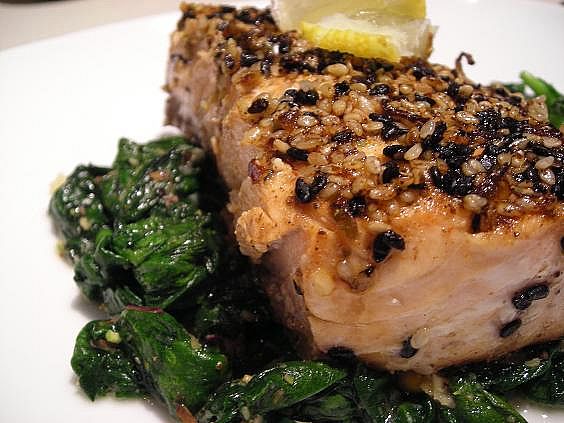 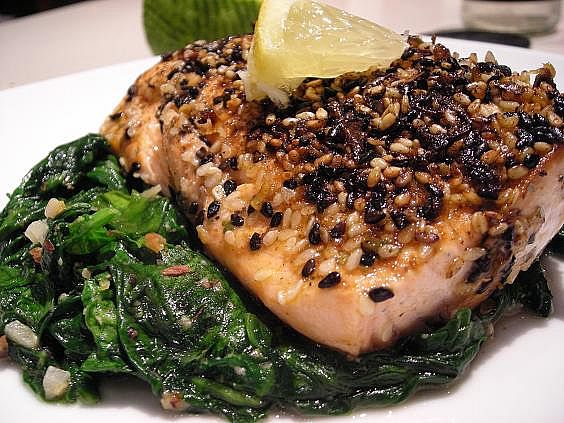
This meal, indulged in on a kid-free night was so full of flavors that Mike and I could do little else but gaze at each other in awe; firm moist salmon with the delightful citrus-y crunch of the sesame crust and my absolute favorite parmesan-garlic sauteed spinach that ended up perfectly cooked even when I was afraid I over-did it.
I made my own Old Bay style blend instead of buying an overpriced tin of it. I’m really a spice hound and have a huge shelf in my kitchen that is full of different spices. I prefer to make my own blends- I made garam masala when I needed it and was able to make a suitable Chines 4-Spice blend that managed quite well without the star anise. Easy access to bulk spices helps too. The recipe for Old Bay that I found on-line required 13 ingredients- I had 12 on hand.
(jump for recipes)
Come in to my kitchen…
February 11th, 2009
| 5 Comments »
Admittedly, I like to break convention. I’m not one to conform to stereo-typing, I don’t mold myself to any expectation and I refuse to adhere myself to a certain role. At home, I’m just as easily found outside shoveling, chopping ice on our north-facing driveway, spreading mulch or digging a hole for a new garden plant as I am in the kitchen whipping up something delicious. I don’t think in terms of ‘mans work’ or ‘womens work’, and while we do have some things in our house that may fall into those categories, I don’t think that any job should be defined by your gender. I would have never succeeded as a single parent for 7 years with that belief.
In my life too, I’m the one who would most likely encourage you to step outside the box. Years ago, in an outing with women I was working with, we spied a parking spot outside our destination on the opposite side of the street from where we were. Here’s me in the backseat telling the driver to make a U-turn, while the other women in the car want to play it safe and go around the block. When I’m in the minority, I tend to be slightly insistent about what I feel, and apparently I was loud enough that the driver whipped around the steering wheel in a speedy U-turn and scored the parking spot. Later she confessed that she’d never done anything like that. I asked her if she liked it, and after a moment’s repose, she replied with a grin “I think I did!” Stepping outside a comfort zone, or taking one of life’s U-turns is hard for some people. I’m generally not one of them.
This trait, good or bad as it can be, is part of me in the kitchen as well, and here it really tends to take off soaring because I’m the majority cook in the family and no one is standing about trying to tell me what to do with a recipe or certain dish. I rarely follow a written recipe, and when I do I’m most always disappointed. I know what I like, and after a lifetime of cooking, making mistakes and blending every ingredient under the sun, I have a storehouse of knowledge in my brain as to what works and what might not. My brain can see how any recipe from any source can become something else altogether, and knows just how to make it delicious.
Take this roasted vegetable pasta dish; I don’t recall the origin of the dish as the only note I have on it says “eggplant, tomato and pasta” – yeah, that’s concise- but I recalled enough to know that you roasted the veggies, pureed them with pasta water and some olive oil and mixed it with cooked rigatoni. I also recalled that the finished dish, while not a beauty queen, was delicious. Sometimes, ‘delicious’ is all I can remember, and really, do you need to know anything else? Well, a method might help.
For my roasted veggies, I used an eggplant and a pint of grape tomatoes, halved. I also cut an onion into eighths, large diced a red pepper and rough chopped six cloves of garlic as additions. Mix it all up in a bowl with a few good glugs of olive oil, some seasoning of choice, and toss.

Don’t give in and add more oil; the notoriously thirsty eggplant will drink up some of it and the rest of the vegetables will get their fair share. Too much oil on eggplant in the oven and it just becomes soggy. Spread the veggies out on cookie sheets, with plenty of room, and roast at 400 until the tomatoes are nice and wrinkly, the eggplant is browned and everything smells amazing. This took me about 25-35 minutes.

Cook the pasta while the veggies roast. You want the pasta water for the puree; I always place a pyrex measuring cup in the colander to help remind me to catch that good starch. Drain the pasta, reserving up to two cups of the water. Keep the pasta warm.
Place the veggies in the food processor with some salt and pepper. You can save some of the roasted pieces to top the pasta, if you wish.
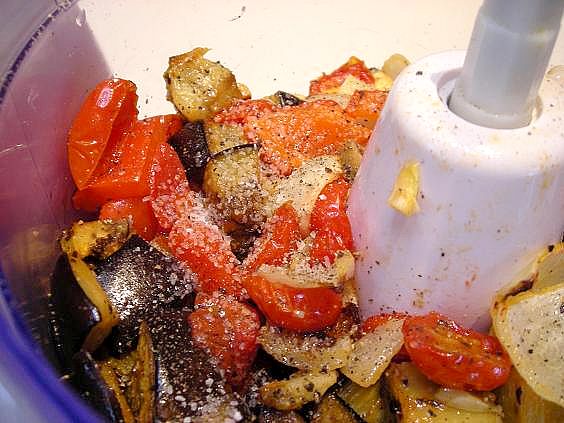
Add in about a cup of the pasta water and another healthy glug of olive oil. Whir the veggies to a consistency of choice- I like it a bit chunky- and scrape down the sides. Now take a look at the mix- it should be fairly thick. Add in a little more pasta water to make it to a spreading consistency. If it’s too thick, it won’t coat the pasta well enough.
You can also add in some kalamata olives, and be sure to have some fresh grated parmesan ready.
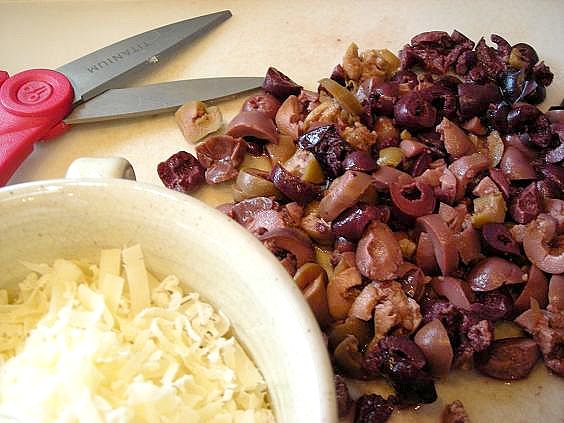
And if you’re like me and enjoy something crunchy, toasted and seasoned on top of your pasta, make some bread crumbs. I took a shortcut this time and put the remains of these bagel chips through the food processor.

Oh my, this was a really good addition!
Once the veggies are processed, scoop some of the puree onto your rigatoni or other large shape of pasta. This is such a hearty dish that a tiny shape would get lost in amongst the lovely vegetable mix. You may not need all the puree so add as you go to make it the consistency you like. Stir, taste, season with salt and pepper and taste some more.
Then, take your serving, add in the parmesan and crumbs and pick up a fork.
 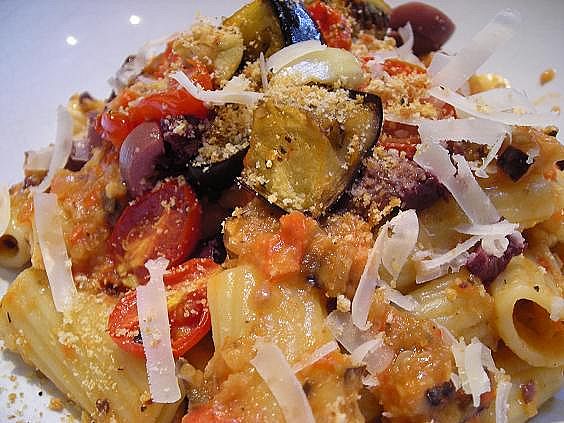
Mmmmm….. who needs convention anyway??
The puree was really thick and delicious- not so visible in these photos but trust me…each bite was a huge flavor burst in the mouth. There was plenty left over even after I coated the pasta with quite a bit. The next day I could hardly wait to take the remains of the vegetable mixture, spread it on toasted peasant bread and top it with fresh mozzarella. This made for a quick and delicious light lunch. I also think it would make a wonderful appetizer for a party.
Ok, if you need a set of instructions, follow the jump…..
Come in to my kitchen…
February 9th, 2009
| Comments Off on Sun in February
February is here and the bitter chill we experienced in January will, hopefully, be all behind us. The light is longer in the afternoon; twilight comes around 6:00pm as opposed to 4:30, and with the last day of our arctic first month we had a brilliant thaw- temps in the 40’s, and a balmy breeze that reminded our frozen extremities that yes, Spring does follow winter, and really, it shouldn’t be too long now. Let’s keep our fingers crossed.

My newly adopted African violets seem to really enjoy our sunroom. I was gifted with an entire collection of them after they failed to thrive, and I am really looking forward to seeing what lovely blossoms they will bestow on me. This one poked it’s head out within days of landing amongst the sun and warmth of our house, looking around as if to brightly proclaim “It’s nice here!”
Still, we need some foods to warm us, to take away the icy feeling that comes from old squeaky snow underfoot (more than three weeks since a measurable snowfall), the harsh almost breakable nights where the stars resemble ice shards in the sky and the wind creeps through even the snuggest of weather-proofing. It may be slightly warmer than our bone-numbing arctic blast of a few weeks ago, but that last push through February and into March, where the calendar brings at least the promise of meteorological Spring even if the atmosphere doesn’t get on board, can seem longer and more pressing than the first few weeks in December where everything seems so dark and heavy. It’s like the last few miles of a strenuous trip to a beloved destination; the haul is long, but the end result is oh so sweet.

The month started out with some beautifully sunny days, although today isn’t one of them. The sunshine makes the house feel very cozy during the day, especially in the second floor bedroom. It’s hard not to curl up against the pillows in the warmth, a good book in my hands and a cup of steaming tea on the bedside table, maybe a purring feline against my leg. Just walking into the room propels me into a different mood, like the warmth and sun work in a swift instant to relax me. It’s best for me to just stay downstairs, focused, a worthwhile endeavor at hand, like stirring together a pot of Red Lentil Dhal.

I’ve done this dish before and was thrilled with the results. Why I don’t put it together more often is beyond understanding; red lentils, of all the lentil types available, cook the quickest with such little effort besides a swishing through water. This recipes calls for a deeply aromatic melange of toasted spices and seeds, creating a smoky taste that permeates each bite. From start to finish, it barely ticked 30 minutes off the clock- enough time for me to switch a load of laundry, gaze outside at the sunshine, scratch a soft warm cat ear. Even if it cooks a little too long you’re not worse for wear. And the flavor is so delicious. Scooped warm over some rice with a few crunchy pistachios as a garnish and my lunch was sunshine-y perfect.
Even though the temperature fluctuates between barely climbing to double digits and then turning around and surpassing the freezing mark, the sunshine made everything seem so much nicer, regardless of the number on the thermostat outside. I’ll keep my fingers crossed that the rest of our winter is friendlier, and my eye on more delicious and warming meals like this one.
That’s a pretty tomato isn’t it?? They are surprisingly flavorful for a winter tomato and my brain is working out all kinds of ways to use them. I think it’s trying to trick me into thinking it’s summer time. A girl can wish, can’t she?
(recipes and notes follow)
Come in to my kitchen…
|














 Tell me if you think those look like they are low in fat.
Tell me if you think those look like they are low in fat. I still love really good bread and for a long time I routinely spun loads of flour, water and yeast in my bread machine, so much so that I managed to effectively kill the thing outright, but I’m happy to have gotten my money’s worth. Since then, which was quite a while ago, I haven’t made a lot of bread from scratch despite having the time and the desire for it. I experimented with t
I still love really good bread and for a long time I routinely spun loads of flour, water and yeast in my bread machine, so much so that I managed to effectively kill the thing outright, but I’m happy to have gotten my money’s worth. Since then, which was quite a while ago, I haven’t made a lot of bread from scratch despite having the time and the desire for it. I experimented with t


















